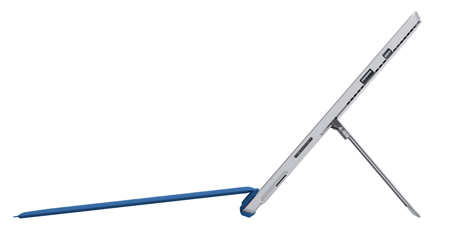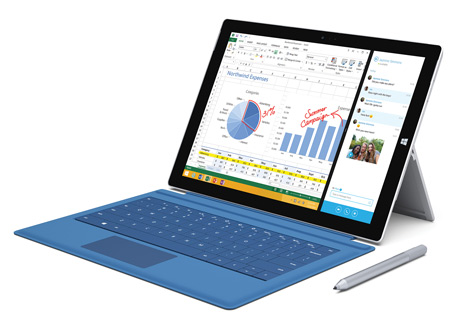In-Depth
Surface Pro 3: Microsoft's Tablet Gets (Even) More Business-Ready
The Microsoft Surface was already the tablet for users looking to combine serious business and serious fun. With the Surface Pro 3, Microsoft is trying even harder to replace your tablet and PC at one stroke. Here's a first look.
- By Jeffrey Schwartz
- June 30, 2014
It's the tablet that can finally replace your laptop or even a MacBook Pro. That's the new tagline for the new Surface Pro 3 and the theme of the new television commercials promoting Microsoft's latest effort to merge the PC and the tablet. And it's how Microsoft Corporate Vice President Panos Panay introduced it at a press conference in New York in late May when the company launched the new Surface Pro 3, which is now available for channel partners to deploy.
The Surface Pro 3 may not be the mass-market item the world thought Microsoft was planning to launch -- a Surface "mini." But the Surface Pro 3 will appeal to business users who tend to travel with both a Windows-based laptop and a tablet -- typically an iPad. At launch, several large organizations are rolling them out, including BMW, Coca-Cola Co. and luxury-goods provider LVMH Moet Hennessy.
Microsoft created its Authorized Device Reseller (ADR) program last July, but with 100 ADRs now in place -- up from 10 at the program's launch -- and a complete marketing and go-to-market team, the new Surface Pro 3 is tailor-fit for the channel, especially for solution providers, according to Jason Graefe, senior director of channel partnerships for Microsoft Surface.
"This is the first product we've launched with our full channel team and our full commercial team in place," Graefe said during an interview at the launch event. "This is the form factor we've been waiting to get to. This is our most commercially relevant device that I believe will help our customers embrace it. We're ready to go."
If the old adage that the third version of a Microsoft product is the one that'll take off, then the new Surface Pro 3 should be a blockbuster. Given the less-than-stellar sales of the first two Surface Pros, along with the compressed release cycles and a highly competitive market, Microsoft will probably settle for a meaningful boost. After spending several weeks with the new Surface Pro 3, there are a lot of reasons to suggest it could be a hit.
The Surface Pro 3 isn't a vast departure from the original concept; it fixes many things that were wrong with the first two Surface Pros. Yet calling it a refined version would be an understatement. The Surface Pro 3 pushes the envelope in what's been shipped to date in a system that aims to be a full-fledged PC and tablet.
In addition to delivering a much-improved system, the Surface Pro 3 is more robust than the Surface Pro 2, which was limited to an Intel 4th Generation i5 Processor with 512GB of storage and 8GB of RAM. Granted, that's not shabby, but the slightly larger Surface Pro 3 is available with Intel's most powerful Core processor, the i7, used for compute and graphics-intensive applications such as computer-aided design.
 Two of the most important new usability features of Surface Pro 3 are visible in profile -- the higher keyboard angle for typing comfort and the more adjustable kickstand.
Two of the most important new usability features of Surface Pro 3 are visible in profile -- the higher keyboard angle for typing comfort and the more adjustable kickstand.
Besides a slightly larger display, the Surface Pro 3 has double the resolution, at 2160x1440 versus 1920x1080. And while it's a bit bigger, the Surface Pro 3 is also lighter and thinner: 1.76 pounds and just 0.36-inch thick versus .53 inches for the Surface Pro 2. Microsoft says it's the thinnest device today powered by an Intel Core processor. It's still very portable yet feels more substantial than its predecessors.
In order to accommodate that lighter, thinner form factor, Microsoft worked closely with Intel to develop a new fan that it claims is 30 percent more efficient than any other portable computer on the market. Microsoft says it also reinvented the fin on the fan, to radially push air throughout the system, thereby ensuring the user can't hear or see it.
Keyboard with an Angle
While I like the prior Surface devices as well, one of my key objections was the angle (or lack thereof) of the keyboard. Its flat positioning can make it tiring to use for long periods of time. I've found the best solution to that is to put a stack of business cards under the device to create a more comfortable angle. Apparently, others also had the same objections. As a result, the Surface Pro 3 keyboard can be positioned on an angle, yet remain firm while you're typing.
Microsoft took great pride when it introduced the Surface 2 and Surface Pro 2 last year, showcasing a redesigned kickstand that users could lock in two different positions. The kickstand on the original Surface and Surface Pro only locked in one position. If you didn't like that angle, you were out of luck. Now, with the Surface Pro 3, the kickstand locks in any position you choose. However, in doing so, I've found it doesn't truly lock like the prior units; rather it's just much stiffer. That's fine if you're using it on a table, desk or flat surface, but if you're using it in your lap there are occasions when it can collapse. It's not a major problem, but it can be annoying when it happens. The fact that you can pitch the keyboard on an angle more than compensates for that.
Among some other noteworthy specs, the Surface Pro 3 has 5MP and 1080p HD front- and rear-facing cameras and, like the prior version, a full-size USB 3.0 port, a microSD card reader and, for enterprise security, an embedded TPM chip.
Tipping the Scales
The larger size, screen resolution and lighter weight of the Surface Pro 3 are the most obvious characteristics, but it was interesting to see Panay compare it to a MacBook Pro. Eying all of the MacBook Pros in the room by reporters taking notes, Panay put the two devices on a scale to show that the MacBook Pro is much heavier. But Panay also demonstrated the fact it can do something the MacBook Pro can't: run the Adobe Creative Cloud (CC) with its multi-touch interface, as well as a new electronic pen.
The new Surface Pen is an integral part of the Surface Pro 3 and not just for designers or engineers. This electronic pen is powered by one AAAA battery, something new to me but apparently they're used in many cameras and other small electronics devices. Using an app like Final Draft, Evernote or even OneNote, a user can write on the device naturally just as if using a pen and paper.
It's no coincidence the actual display is 8x11.5 inches, almost the size of a standard sheet of paper or notepad. If you want to drop notes onto it, you can sync it with your other devices via OneDrive. I haven't spent much time with this feature, but perhaps it's an antidote for all those Post-It Notes on your desk. For those working in the field, the ability to take notes, draw diagrams or annotate documents could be a welcome feature.
 With a screen close to the size of a standard sheet of paper and a digital pen, the Surface Pro 3 is engineered for jotting down thoughts.
With a screen close to the size of a standard sheet of paper and a digital pen, the Surface Pro 3 is engineered for jotting down thoughts.
More Power
Even though it's bigger and has a higher resolution display, the Surface Pro 3 is rated at 15 percent to 20 percent more battery life than any of the prior Surface devices Microsoft has shipped. Microsoft claims 9 hours when used for typical Web browsing. When I've used it in the field, it just eked out about 8 hours, though I did have the screen brightness as high as it goes. Lowering the brightness halfway could certainly help squeeze another hour or so out of it. I was disappointed Microsoft didn't announce a battery pack keyboard like the one it offers for the Surface 2 and Surface Pro 2, nearly doubling the battery capacity. True, it adds weight, but it could be worth it if you're using it all day and don't want to or can't plug it in. Microsoft wouldn't say if a Power Cover is in the cards for the Surface Pro 3.
If having 14 hours of battery life is a requirement but you find the Surface Pro 2 lacking or too small, Hewlett-Packard Co. last month previewed the new HP Pro x2 612, which, with an optional battery-powered keyboard, will provide that amount of power. However, that unit, unveiled at the Computex trade show in Taipei, isn't scheduled to ship until September. HP hasn't disclosed pricing and it will be interesting to see where it comes in compared to the similarly configured Surface Pro 3.
The only problem I encountered was it would it would lose connectivity on occasion. Because it has happened in multiple locations, I've ruled out the nearby router as the cause. When troubleshooting, Windows diagnostics would state the network adapter is experiencing driver- or hardware-related problems. Microsoft says I'm the only one it has heard from experiencing this problem. Rebooting the system always seems to fix it.
A fully configured Surface Pro 3 won't come cheap. While the company promotes an entry-level version at $799, that device is based on an i3 processor and 4GB of RAM and 64GB of storage. Even if you don't use a lot of heavy-duty apps or do much multitasking, for $999 you get a 128GB SSD and an i5 processor. The test unit I have has a 256GB SSD, 8GB of RAM and an i5 processor, which sells for $1,299. Boost it up to an i7 processor and you're up to $1,549. Bump that up to an i7 with 512GB of storage and it costs $1,949. None of those prices include a keyboard, which costs an extra $129.99. Other options include a $199 docking station and an Ethernet adapter.
If you're looking for a business-class laptop that weighs and feels like a tablet, the Surface Pro 3 is a worthy contender. As Microsoft has set out to do, it will raise the bar for its OEM partners.
Related: